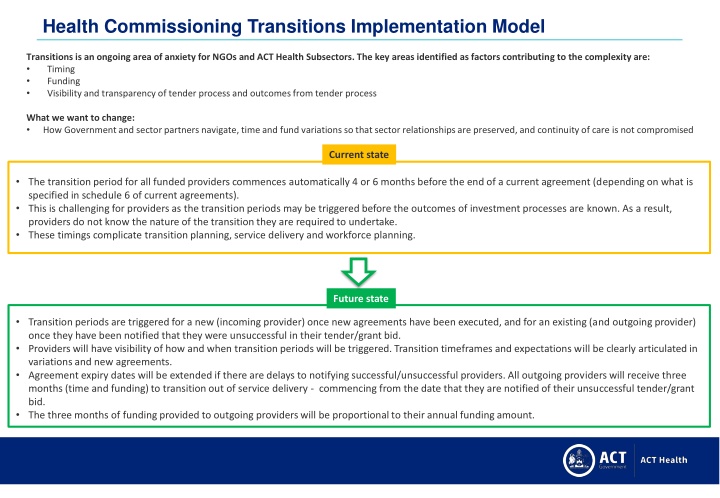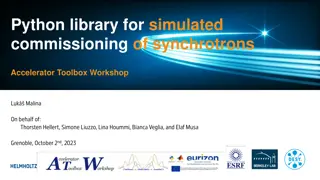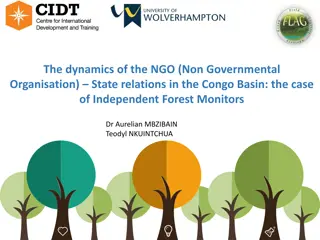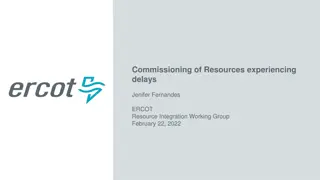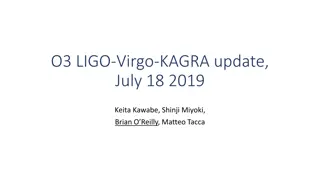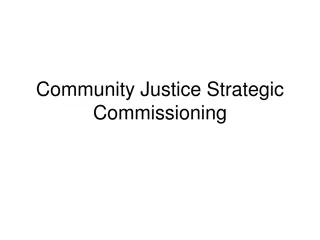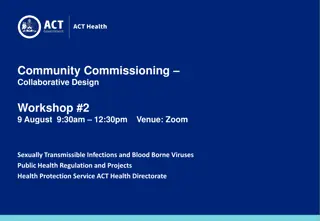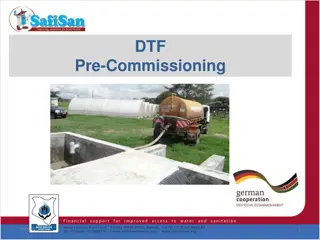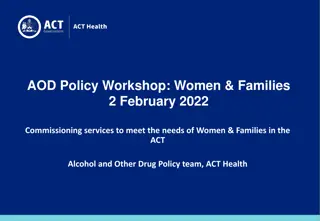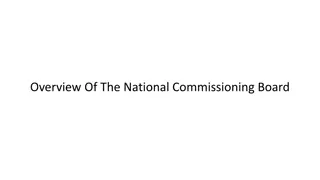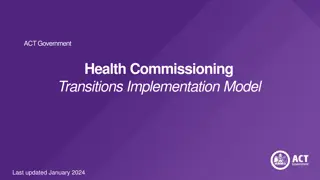Improving Health Commissioning Transitions for NGO and Health Sectors
Addressing the challenges in transition periods for health service providers by ensuring clearer communication, adequate time for transitions, and transparent funding processes to maintain sector relationships and continuity of care. The current state involves automatic transition triggers before outcomes are known, leading to planning complexities. The future state proposes triggered transition periods post-agreement executions, clear articulation of timeframes and expectations, and funding extensions for outgoing providers, allowing for smooth service delivery transitions.
Download Presentation

Please find below an Image/Link to download the presentation.
The content on the website is provided AS IS for your information and personal use only. It may not be sold, licensed, or shared on other websites without obtaining consent from the author.If you encounter any issues during the download, it is possible that the publisher has removed the file from their server.
You are allowed to download the files provided on this website for personal or commercial use, subject to the condition that they are used lawfully. All files are the property of their respective owners.
The content on the website is provided AS IS for your information and personal use only. It may not be sold, licensed, or shared on other websites without obtaining consent from the author.
E N D
Presentation Transcript
Health Commissioning Transitions Implementation Model Transitions is an ongoing area of anxiety for NGOs and ACT Health Subsectors. The key areas identified as factors contributing to the complexity are: Timing Funding Visibility and transparency of tender process and outcomes from tender process What we want to change: How Government and sector partners navigate, time and fund variations so that sector relationships are preserved, and continuity of care is not compromised Current state The transition period for all funded providers commences automatically 4 or 6 months before the end of a current agreement (depending on what is specified in schedule 6 of current agreements). This is challenging for providers as the transition periods may be triggered before the outcomes of investment processes are known. As a result, providers do not know the nature of the transition they are required to undertake. These timings complicate transition planning, service delivery and workforce planning. Future state Transition periods are triggered for a new (incoming provider) once new agreements have been executed, and for an existing (and outgoing provider) once they have been notified that they were unsuccessful in their tender/grant bid. Providers will have visibility of how and when transition periods will be triggered. Transition timeframes and expectations will be clearly articulated in variations and new agreements. Agreement expiry dates will be extended if there are delays to notifying successful/unsuccessful providers. All outgoing providers will receive three months (time and funding) to transition out of service delivery - commencing from the date that they are notified of their unsuccessful tender/grant bid. The three months of funding provided to outgoing providers will be proportional to their annual funding amount.
Transition arrangement (current provider is the preferred respondent) Transition period Service delivery intensity Current provider 6 2 3 5 1 BAU Service Delivery Maintain/adjust service delivery 4 Time The provider will maintain agreed service delivery thresholds during the transition period. 4 The current provider is funded to deliver services under the current agreement. 1 The current provider s tender/grant submission has been selected as the preferred submission and they have been informed of their successful bid (preferred provider). Negotiations with the preferred provider will be undertaken to develop the new agreement. Negotiations will include transition-in arrangements for the new agreement. Services and funding will be provided in full under the current agreement until the execution of the new agreement (no formal transition out). 2 Transition period ends and provider has successfully transitioned service delivery into BAU. 5 BAU service delivery levels (and subsequent funding) under the new agreement may be different to the previous agreement. Service models and funding are subject to the outcomes of Commissioning Design and Investment, and reflect shifts in: Demographic characteristics of the population (including new priority cohorts) Service requirements (e.g., as a result of a new industry requirement or data) The health priorities to be addressed or outcomes to be achieved Available funding 6 Execution of the new agreement. The provider will commence an internal transition between the old service model/s and the new service model/s. The new agreement will recognise that the provider may need to realign resources to meet the new service delivery requirements, and that there may be a need for flexibility in how services are delivered during the transition period, whilst ensuring there are no adverse impacts to client health and wellbeing. Service flexibility thresholds will be negotiated between the provider and ACTHD relationship/contract managers (during step 3). Funding will be provided as usual under the new agreement (including during the transition period). 3
Transition arrangement (when a new provider is successful in a tender bid) Transition period (3 months) Service delivery intensity Transition into BAU BAU Service Delivery 3 New provider/s New agreement begins Current provider/s Transition of services will be accomplished by a scaling back of service delivery intensity for the outgoing provider, while the incoming provider ramps up its service delivery. Funding for outgoing and incoming providers will be adjusted during the transition period to reflect these changes in service delivery intensity and available budget. 1 2 1 2 Delivers services. Has variation with new clauses in-situ Receives notification of unsuccessful tender. Transition-out period is triggered Service delivery ceases 3 Year The current provider is funded to deliver services under the current agreement. All current agreements will be varied to include new clauses relating to the return of unspent funds and the new transition period (3 months before the agreement expiry date or 3 months from notification of non-preferred providers). 1 Successful respondent is selected and notified, and negotiation is undertaken for a new agreement. 1 The new agreement is executed, and this marks the start of the transition-in period for the new provider and commencement of service delivery. The new agreement will recognise that there may need to be flexibility in how services are delivered during the transition-in period, as long as there are no adverse impacts to client health and wellbeing. Service flexibility thresholds will be negotiated between the provider and ACTHD relationship/contract managers (during step 1). Funding will be provided proportional to service delivery thresholds during the transition-in period. Full funding will be provided once the transition-in period has ended, and service capacity and delivery is at BAU expectations. 2 2 If the current provider is not successful in their bid for the new service delivery, they will be notified that they are a non-preferred provider . Non-preferred providers will then commence their transition-out. Typically, this will be 3 months before the expiry of the agreement. If non-preferred providers are notified earlier than 3 months before the expiry date of their agreement, they may be offered an earlier expiry date to coincide with the earlier commencement of the transition-out period. If non-preferred providers are notified within 3 months of the expiry of their agreement, they will be offered an extension to the expiry date to ensure a full 3-month transition period is provided from notification. The new provider successfully transitions service delivery into business as usual. Services may be different to those provided by a previous provider, depending on community need and what is stipulated in the new agreement. 3 For any extensions to expiry dates, transition-out funding will be provided to outgoing providers as a proportion of their annual core funding for the extension period. 3 The transition period and current agreement expire. Whilst the transition-out period will be a consistent 3 months for all providers transitioning out, transition-out may or may not result in additional time beyond the length of a provider s previous agreement (depending on when unsuccessful providers are notified - the transition trigger) Please note: Negotiations with preferred providers will occur during the transition-out period. If by chance these negotiations fall through, ACTHD reserves the right to contact a non-preferred provider to engage them in negotiations as a preferred provider. Note: The funding available for service delivery within the subsector may be reduced for the first year of new agreements so that funding can be redirected to cover transition-out periods. Funding will return to normal allocation for all providers in year 2 of agreements. The year-to-year funding breakdowns will be clearly articulated in new agreements. Any unspent funds recovered from providers will also support transition funding.
New transition clauses (for all new Health Commissioning cycle timeline variations) Key changes to existing agreements which support the new transitions approach: 1. The reimbursement of reasonable costs clauses have been replaced with a new unspent funds clause which will require the provider to return any unspent funds to the Territory upon expiration of the agreement. 2. New clauses will require providers to develop a detailed Transition Plan within 4 weeks of execution of the variation. The expectations for providers who are transitioning out are also articulated within the agreement. 3. Agreement wording specifies that the transition period commences 3 months before the expiry date. However, to ensure that all outgoing providers receive a full 3 months to transition (time and proportional funding), the new agreement will allow for: an earlier expiry date if non-preferred providers are notified earlier than 3 months from the agreement expiry date; or A later expiry date if non-preferred providers are notified within 3 months from the agreement expiry date
The Health Commissioning Transitions Implementation Model in action The below provides a snapshot of the end-to-end process of the model and how it will work in practice. Approach to Market BAU Service delivery Variations Notification Transition Preferred providers are notified Potential overlap in service delivery between new/continuing providers and providers who are transitioning out (depending on when new agreements are executed in relation to notification of non-preferred providers. New service system in action Current agreements will be varied to include new transition information/clauses relating to: Grant/tender documents developed Non-preferred providers are notified of the grant/tender outcome and commencement of transition-out period. Grants/tender goes out to the sector New agreement expiry date Recovery of unspent funds Transition period length Expectations for transition preparedness Grants/tender closes New agreement terms negotiated with preferred providers. Providers who are transitioning out will do so in accordance with contractual requirements and their Transitions Plans. Grant/tender submissions are assessed New agreements are signed and executed. Non-preferred providers who are not engaged during contract negotiations are notified that they have been unsuccessful in the tender/grant process. Clients attached to outgoing providers will need to be transitioned to a new provider or out of service delivery if safe and appropriate.
